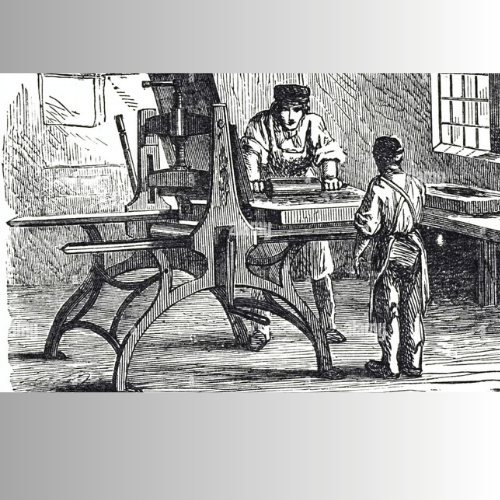The first printing began in China in the 9th century AD. First started printing through burnt clay plaque, vellum, stone plates, metal sheets, the bark of a tree, etc. A text was heated on the ash and the clay type was placed on it. The sheet of soil was used as mold. In which paint was applied to the mold, paper was pressed, characters were printed, and the printing process was performed.

Expanding the ancient history of printing in Europe
- Ancient history of printing in Garman: Johann Gutenberg of Germany and Laurence Koster of Holland introduced the first printing in Europe by creating individual types. But circumstantial evidence gives Gutenberg the honor of being the first printer. The city is named after Johann Gutenberg. It is believed that in 1848, he set up a printing press in Mainz and printed a book called the Vulgate Bible for the first time. And this was the first printed book in Europe, in 1456 AD. He borrowed money from a wealthy goldsmith named Johann Furst to print the Bible in Latin. Each page had 42 lines, hence the 42-line Bible. But Gutenberg’s Bible was better known and is his most famous achievement.

- Ancient history of printing in Italy: After Germany, printing flourished in Italy. Two German printers set up a printing press in 1465 AD in a village on the way to Rome. Konrad Schwanheim and Arnold Panerz were behind these two German publishers, respectively. They took refuge in a church in a village in Italy called Suffian in 1462 AD and published four books between October of that year and 1467 AD.

- Ancient history of printing in France: The printing press was permanently installed in France in 1470 AD. 1458 AD King Charles VII sent his mint master Nicholas to the town of Mainz to teach printing techniques. But when Johnson returned in 1461 to learn printing, Charles died. So he went to Venice in sorrow, unable to set up a printing press there, despite much trouble. Later in France, the printing press was installed by the university’s two professors named Ja Heinlein and Guillaume Fitchet. Some classic and academic textbooks were printed there. Then printing spread to other European countries, such as 1473 AD in Holland, Belgium and Spain, 1482 AD in Denmark, 1483 AD in Sweden and 1489 AD in Portugal.

- Ancient history of printing in England: William Coxton was England’s first printer. He was born in 1422 AD in Tenderden, Kent. Some believe he was born in 1423 AD. Caxton 22 years younger than Gutenberg. Education in England was not that widespread at that time, but luckily his parents sent him to school, and after school he apprenticed with a machinist. After his death, he traveled to various countries in Europe and acquired extensive knowledge of public affairs. He was first introduced to the printing press when he came to Brussels. From then on, he became obsessed with the invention of the printing press. He printed more than 100 books in these 16 years from 1475 AD to 1491 AD. The first book printed in it was called “Wise Words”. Later it was translated into Persian and English.

Then in 1640, the first book was printed in America. In 1876, the first printing press was established in the city of Sabrian, Burma. In 1816, another Burmese book “The Way of Heaven” was published in the printing house of American missionary George Hone. 1730 AD the first printing press was set up in Sri Lanka. 1870 AD, Japan first imports European printing press.
What global changes resulted from the printing press:
The invention of the printing press by Johannes Gutenberg in the mid-15th century had profound and far-reaching effects on the world. Here are some of the key ways it changed the world:
- Increased Access to Information:
Before the printing press, books were copied by hand, making them rare and expensive. The printing press allowed for the mass production of books, significantly lowering their cost and making them more accessible to a wider audience.
- Spread of Knowledge and Literacy:
The printing press facilitated the spread of knowledge and ideas. It played a crucial role in the dissemination of scientific, religious, and philosophical texts. This contributed to the rise in literacy rates as more people had access to reading material.
- Scientific Revolution:
The ability to produce and disseminate scientific works quickly and accurately helped propel the Scientific Revolution. Scientists could share their discoveries more easily, leading to a rapid accumulation of knowledge and fostering collaboration.
- Reformation and Religious Changes:
The printing press was instrumental in the Protestant Reformation. Martin Luther’s 95 Theses were widely distributed thanks to the printing press, challenging the Catholic Church’s authority and leading to significant religious and political changes in Europe.
- Standardization of Languages:
The printing of books in vernacular languages contributed to the standardization and development of those languages. This was a significant factor in the development of national identities.
- Cultural and Intellectual Movements:
The Renaissance benefited greatly from the printing press as it allowed for the revival and spread of classical knowledge and new ideas. It fostered an environment of intellectual exchange and cultural flourishing.
- Economic Impact:
The printing industry itself became a significant economic sector, creating jobs and contributing to the growth of commerce and trade. The increased availability of printed materials also supported the education sector and other industries.
- Political Changes:
The spread of printed material contributed to the development of public opinion and the spread of political ideas. This had a long-term impact on governance and the development of democratic ideals.
Overall, the printing press was a revolutionary technology that transformed society by democratizing access to information, fostering education and literacy, and enabling widespread cultural, religious, scientific, and political changes.



